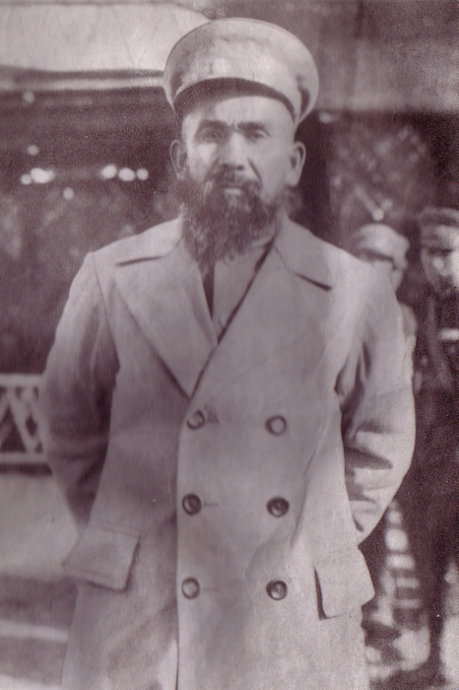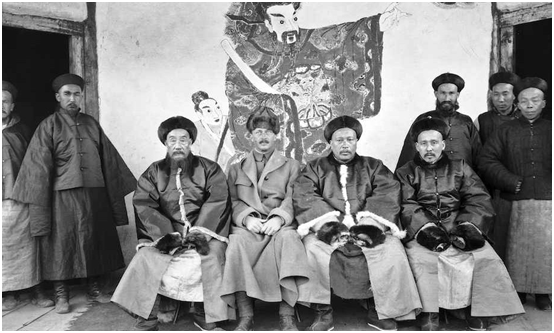|
Sabit Damulla Abdulbaki
Sabit Damolla ( ug, سابىت داموللا; ; June 1883 – 1934) was a Uyghur independence movement leader who led the Hotan rebellion against the Xinjiang Province government of Jin Shuren and later the Uyghur leader Khoja Niyaz. He is widely known as the first and only prime minister of the short-lived Islamic Republic of East Turkestan from November 12, 1933 until the republic's defeat in May 1934. Life Sabit Damolla Abdulbaqi was born in 1883, in county of Atush (Artux) in the Kashgar vilayet, where he received religious education. In the 1920s, he graduated from Xinjiang Academy of Politics and Laws in Ürümqi (later becoming Xinjiang University), that was founded by Governor Yang Zengxin in 1924 and originally performed courses in Russian, Chinese and Uyghur. After completing university, he visited the Middle East, touring Saudi Arabia, Turkey and Egypt; he also visited the Soviet Union, where he continued his studies. In 1932 he returned to Xinjiang through India, ... [...More Info...] [...Related Items...] OR: [Wikipedia] [Google] [Baidu] |
Prime Minister
A prime minister, premier or chief of cabinet is the head of the cabinet and the leader of the ministers in the executive branch of government, often in a parliamentary or semi-presidential system. Under those systems, a prime minister is not the head of state, but rather the head of government, serving under either a monarch in a democratic constitutional monarchy or under a president in a republican form of government. In parliamentary systems fashioned after the Westminster system, the prime minister is the presiding and actual head of government and head/owner of the executive power. In such systems, the head of state or their official representative (e.g., monarch, president, governor-general) usually holds a largely ceremonial position, although often with reserve powers. Under some presidential systems, such as South Korea and Peru, the prime minister is the leader or most senior member of the cabinet, not the head of government. In many systems, the prim ... [...More Info...] [...Related Items...] OR: [Wikipedia] [Google] [Baidu] |
Soviet Union
The Soviet Union,. officially the Union of Soviet Socialist Republics. (USSR),. was a List of former transcontinental countries#Since 1700, transcontinental country that spanned much of Eurasia from 1922 to 1991. A flagship communist state, it was nominally a Federation, federal union of Republics of the Soviet Union, fifteen national republics; in practice, both Government of the Soviet Union, its government and Economy of the Soviet Union, its economy were highly Soviet-type economic planning, centralized until its final years. It was a one-party state governed by the Communist Party of the Soviet Union, with the city of Moscow serving as its capital as well as that of its largest and most populous republic: the Russian Soviet Federative Socialist Republic, Russian SFSR. Other major cities included Saint Petersburg, Leningrad (Russian SFSR), Kyiv, Kiev (Ukrainian Soviet Socialist Republic, Ukrainian SSR), Minsk (Byelorussian Soviet Socialist Republic, Byelorussian SSR), Tas ... [...More Info...] [...Related Items...] OR: [Wikipedia] [Google] [Baidu] |
Hoja-Niyaz
Khoja Niyaz, also Khoja Niyaz Haji ( ug, خوجا نىياز ھاجى, Xoja Niyaz Haji; ; 1889 – 21 August 1941), was a Uyghur independence movement leader who led several rebellions in Xinjiang against the Kumul Khanate, the Chinese governor Jin Shuren and later the Hui warlord Ma Chung-ying. He is best remembered as the first and only president of the short-lived Islamic Republic of Eastern Turkestan from November 1933 until the republic's defeat in 1934. Early life and uprisings Khoja was born in 1889 in a small mountainous village in Kumul Prefecture, Xinjiang. He participated in his first rebellion at the age 18, joining a 1907 uprising of peasants and mountaineers against Shah Maqsud, hereditary ruler of Kumul (who was allowed semi-autonomous rule by Qing China). After being defeated, he fled to the Turpan region, where he entered "Astana," religious school and became acquainted with future prominent Uyghur Turpan revolutionary leaders, brothers Maksut and Mahmut ... [...More Info...] [...Related Items...] OR: [Wikipedia] [Google] [Baidu] |
Aksu City
Aksu is a city in and the seat of Aksu Prefecture, Xinjiang, lying at the northern edge of the Tarim Basin. The name Aksu literally means "white water" (in Turkic) and is used for both the oasis town and the Aksu River. The economy of Aksu is mostly agricultural, with cotton, in particular long-staple cotton ('' Gossypium hirsutum''), as the main product. Also produced are grain, fruits, oils and beets. The industry mostly consists of weaving, cement and chemical industries. The land currently under the administration of the Aksu City is divided in two parts, separated by the Aral City. The northern part hosts the city center, while the southern part is occupied by the Taklamakan Desert. Aksu airport is considered a military airport in China (although also available for civil usage). Only aircraft registered in China can land in Aksu. This means if you are flying to Aksu from international origins you have to land in a major airport in China like Beijing, Shanghai, Guangzhou ... [...More Info...] [...Related Items...] OR: [Wikipedia] [Google] [Baidu] |
Turkic Peoples
The Turkic peoples are a collection of diverse ethnic groups of West, Central, East, and North Asia as well as parts of Europe, who speak Turkic languages.. "Turkic peoples, any of various peoples whose members speak languages belonging to the Turkic subfamily...". "The Turkic peoples represent a diverse collection of ethnic groups defined by the Turkic languages." According to historians and linguists, the Proto-Turkic language originated in Central-East Asia region, potentially in Mongolia or Tuva. Initially, Proto-Turkic speakers were potentially both hunter-gatherers and farmers, but later became nomadic pastoralists. Early and medieval Turkic groups exhibited a wide range of both East Asian and West-Eurasian physical appearances and genetic origins, in part through long-term contact with neighboring peoples such as Iranian, Mongolic, Tocharians, Yeniseian people, and others."Some DNA tests point to the Iranian connections of the Ashina and Ashide,133 highlighti ... [...More Info...] [...Related Items...] OR: [Wikipedia] [Google] [Baidu] |
Dungan People
Dungan, Xiao'erjing: ; zh, s=东干族, t=東干族, p=Dōnggān zú, w=Tung1kan1-tsu2, , Xiao'erjing: ; russian: Дунгане, ''Dungane''; ky, Дуңгандар, ''Duñgandar'', دۇنغاندار; kk, Дүңгендер, ''Düñgender'', دٷڭگەندەر is a term used in territories of the former Soviet Union to refer to a group of Muslim people of Hui origin. Turkic-speaking peoples in Xinjiang Province in Northwestern China also sometimes refer to Hui Muslims as Dungans. In both China and the former Soviet republics where they reside, however, members of this ethnic group call themselves Hui because Dungans are descendants of historical Hui groups that migrated to Central Asia. In the censuses of the countries of the former Soviet Union, the Dungans (enumerated separately from Chinese) are found in Kazakhstan (36,900 according to the 1999 census), Kyrgyzstan (58,409 according to the 2009 census) and Russia (801 according to the 2002 census). [...More Info...] [...Related Items...] OR: [Wikipedia] [Google] [Baidu] |
Turkish Islamic Republic Of East Turkestan
The Turkic Islamic Republic of East Turkestan (TIRET; ug, شەرقىي تۈركىستان تۈرك ئىسلام جۇمھۇرىيىتى, , Шәрқий Түркистан Түрк-Ислам Җумхурийити; ) was a short-lived breakaway Islamic republic founded on 12 November 1933; it was the first state to style itself an "Islamic republic." It was centred on the city of Kashgar in what is today Xinjiang Uyghur Autonomous Region. Sometimes referred to simply as the East Turkestan Republic (ETR), it was primarily the product of an independence movement of the Uyghur population living there and more broadly of Turkic-ethnicity in character, including Kyrgyz and other Turkic peoples in its government and its population. With the sacking of Kashgar in 1934 by Hui warlords nominally allied with the Kuomintang government in Nanjing, the first ETR was effectively eliminated. Its example, however, served to some extent as inspiration for the founding of a Second East Turkes ... [...More Info...] [...Related Items...] OR: [Wikipedia] [Google] [Baidu] |




